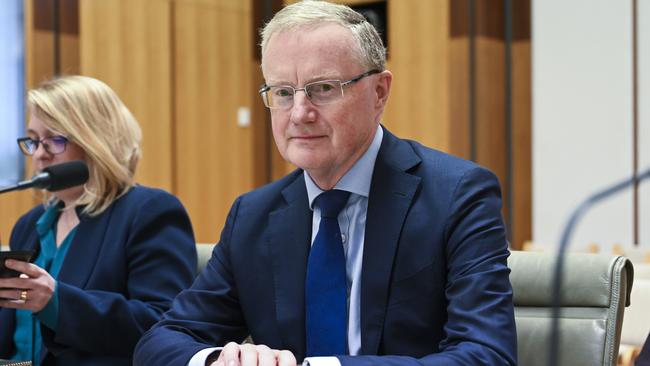Outgoing Reserve Bank boss Philip Lowe warns productivity needs to improve to beat inflation
Outgoing governor Philip Lowe has told a parliamentary hearing there would be major ramifications if productivity did not return to pre-Covid levels.
Interest rates and inflation will stay higher for longer if productivity in the Australian economy does return to pre-Covid levels, outgoing Reserve Bank governor Philip Lowe says.
Addressing the House of Representatives Standing Committee on Economics for the final time as governor of the country’s central bank, Dr Lowe said inflation will struggle to return to its target band of 2-3 per cent if measures to boost productivity were not introduced.
It comes as Dr Lowe, who will be replaced next month by deputy governor Michele Bullock, warned that “it is possible that some further tightening of monetary policy” will be required to ensure that inflation returns to its 2-3 per cent target within a reasonable time frame.
Interest rates have risen by 400 basis points to 4.1 per cent since the RBA delivered its first rate rise in the current cycle back in May 2022 and the RBA has said that further hikes would depend upon the data and the board’s evolving assessment of the outlook and risks.
Dr Lowe said that services price inflation could stay high and extend the period that inflation remained elevated.
“The high services price inflation reflects a combination of factors, including strong demand for services in the wake of the pandemic, stronger growth in nominal wages and incomes, and weak productivity growth,” he said.
“This weak productivity growth is a particular problem for many reasons. Among these is that, in combination with a high level of aggregate demand, it is adding to the upward pressure on prices.”

The governor said that the RBA’s forecasts have been prepared on the basis that growth in productivity picks up to be close to the rate in the years before the pandemic, which would contribute to a moderation in growth in unit labour costs and thus inflation.
“If this pick-up in productivity does not occur, all else constant, high inflation is likely to persist, which would be problematic,” Dr Lowe said.
He added that persistent high inflation could see inflation expectations adjust upwards by both business and consumers and as a result adjust their behaviour.
“This would make the task of controlling inflation more difficult and likely lead to a sharper slowing in output and a greater loss of jobs,” he said.
Citi analyst Faraz Syed said a productivity rebound assumed by the RBA in its forecasts is likely to disappoint policy makers and contribute to further rate hikes.
“We remain bearish on productivity growth and continue to expect two additional rate hikes by the Bank this year in October and November for a terminal rate of 4.6 per cent,” Mr Syed said.
He expected services inflation to accelerate alongside persistent wage price increases over the next 18 months.
“Australia’s 2Q national accounts data will also likely show a further decline in productivity and an acceleration in unit labour costs – both which point to monetary conditions needing to be ‘calibrated’ further into tightening territory,” Mr Syed said.
Dr Lowe said that Australian monetary policy was now into a “calibration phase” where the RBA is “watching the economic data every single month” and “I hope” making “only small adjustments” in interest rates.
Dr Lowe says that in order to lower inflation to the 2-3 per cent target band, the RBA will need see some moderation in unit labour costs in the Australian economy.
“This is why a pick-up in unit labour productivity is so important,” he said.
He added a 4 per cent wages growth would be consistent with the inflation target provided productivity growth improves to pre-pandemic levels.
The governor also told the hearing that the RBA plans to appoint a chief operating officer to help achieve the objective of the central bank being an open and dynamic organisation and that operations are as efficient as they can be.
As part of sweeping changes to be introduced at the RBA following an independent review handed down earlier this year, Dr Lowe said that it made sense to take the time to get details instead of a fast implementation.
“This is especially so given the structure of the proposed Monetary Policy Board is unique, being very different from arrangements elsewhere in the world. Most of its members will spend most of their time outside, not inside, the central bank and the Board will include the Treasury Secretary,” he said.
“Both aspects are unusual internationally. There are very good arguments for this structure, but it does have implications for how the new Board works and communicates.”
At the parliamentary hearing, Dr Lowe also commented that surging population growth, up 2.5 per cent in the past year, was among the main reasons behind rebounding house prices with new supply only increasing by 1.5 per cent over the same period.
The second reason was a perception that a peak of interest rates is near and that nominal income has risen quickly because of inflation.
Dr Lowe expects each of these factors to moderate from here, with a rise in the unemployment rate set to weaken overall income growth.



To join the conversation, please log in. Don't have an account? Register
Join the conversation, you are commenting as Logout